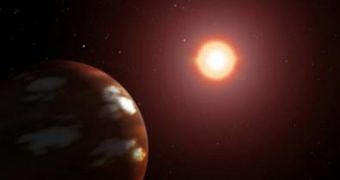European astronomers have just discovered a strange planet roughly the size of Neptune, made of hot, solid water. It has been named GJ 436b and it orbits a cooler red star located about 30 light-years away from Earth.
The existence of hot ice is possible, although never encountered in nature on our planet. This could mean other planets outside our solar system may as well be covered in ice, given the right temperature and pressure.
Frederic Pont and other astronomers at the Geneva Observatory, who made the discovery, explain the strange concept of solid hot ice: "The water is frozen by the pressure but it's hot. It's a bit strange - we are used to water changing conditions because of temperature, but in fact water can also be solidified by pressure."
In fact, ice forms on Earth when liquid water is cooled below 0 ?C (273.15 K, 32 ?F) at standard atmospheric pressure. But high pressure decreases its melting point, forcing ice back into a liquid state.
Unfortunately, the conditions on the surface make the existence of life on it highly unlikely, as the planet is also covered in a layer of hydrogen. This doesn't rule out the possibility of other planets having ice or liquid water on the surface, it actually increases the chances.
"It's not a very welcoming planet," Frederic Pont, an astronomer who helped make the discovery, said in a telephone interview. "The planet is hot because it is near its star and under high pressure because of its mass."
The planet is a rarity among the other 200 in the extrasolar space discovered so far. "The mass and radius that we measure for GJ 436b indicate that it is mainly composed of water ice. It is an 'ice giant' planet like Uranus and Neptune rather than a small-mass gas giant or a very heavy 'super-Earth,'" the astronomers reported.

 14 DAY TRIAL //
14 DAY TRIAL //